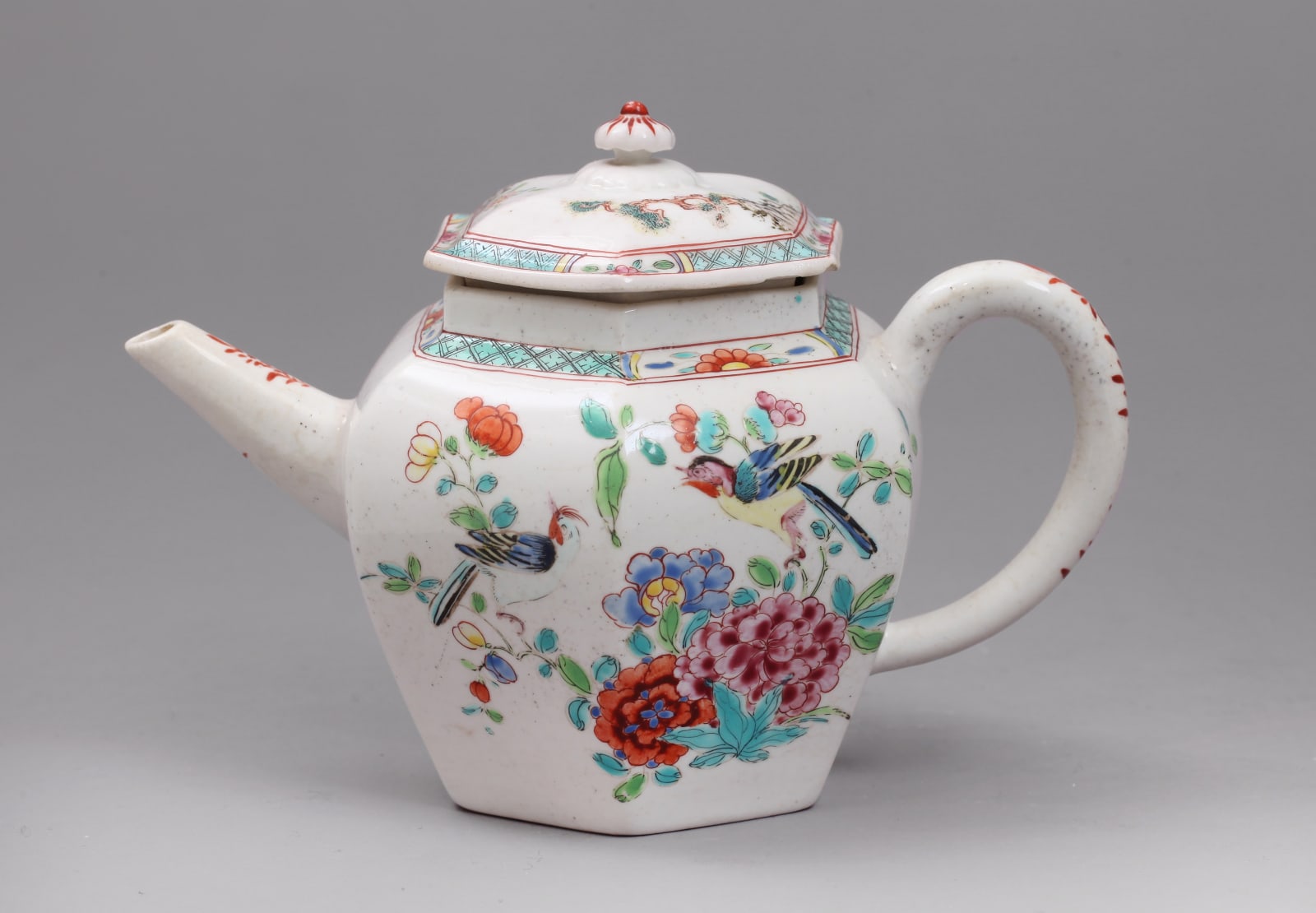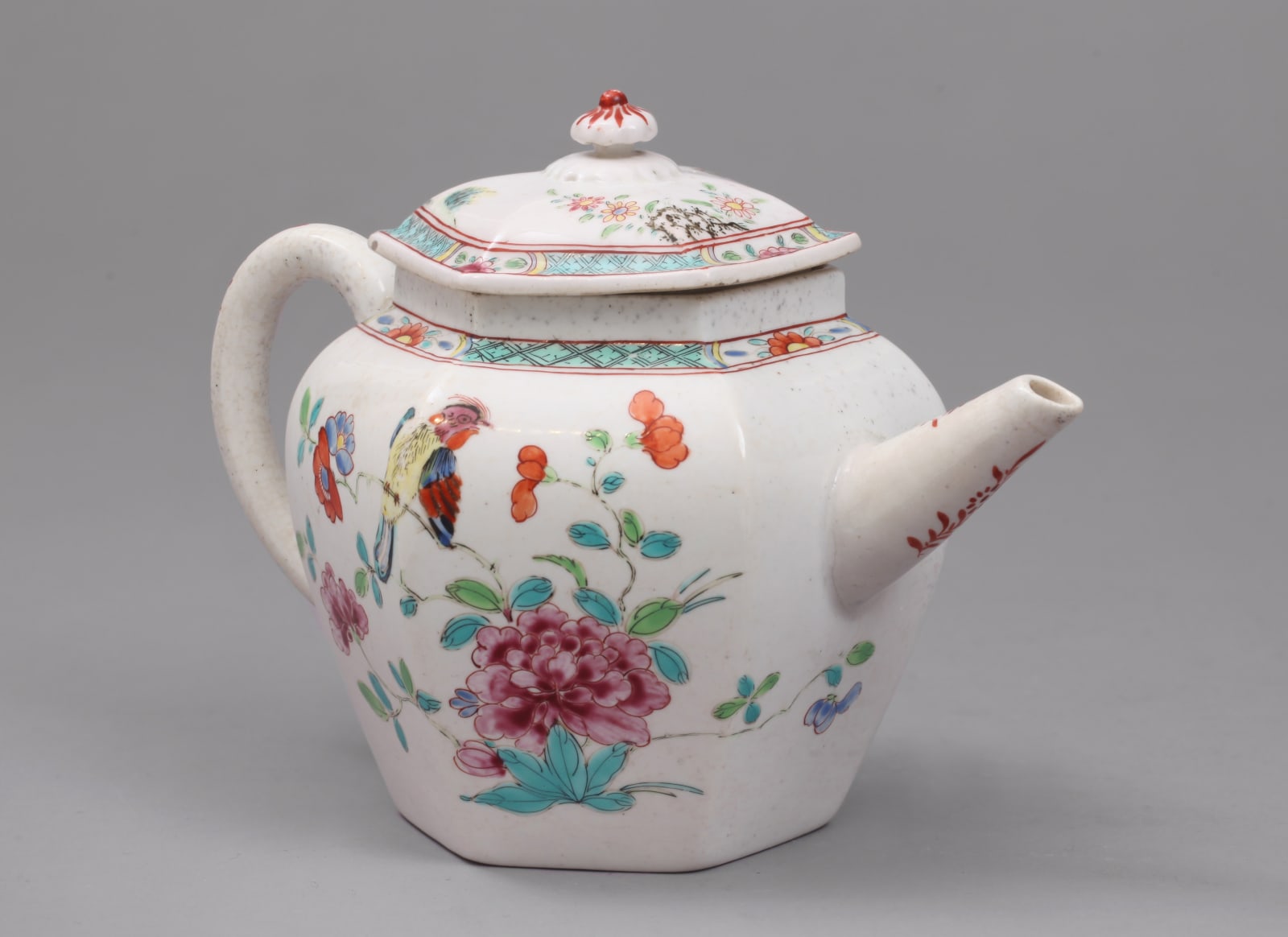

An extremely rare and highly important Chelsea porcelain Chinoiserie Hexagonal Teapot and Cover, Circa 1750-52
An extremely rare and highly important Chelsea porcelain Chinoiserie Hexagonal Teapot and Cover of the raised Anchor period of Manufacture, with applied looped handle and straight spout. Beautifully painted in the rare famille rose palette in delicate pastel tones with a pair of brightly coloured birds in tones of blue, yellow, puce and iron red, perched within stylised and delicate flowering and leafy branches that issue from large and flamboyant peonies and other flowering shrubs, a similar larger bird on the other side with well balanced and large blooming peonies and further branches from which further stylised and delicate blooms appear, beneath a panelled border composed of turquoise enriched with diaper and flowering chrysanthemum framed with iron red lines. The raised panelled Cover with rising formal flower finial and matching famille rose decoration.
The only example of a teapot of its type of decoration currently known. Famille rose decoration on raised anchor period Chelsea pieces is extremely rare, with only one other famille rose teapot recorded and illustrated in Dr F Severne MacKenna, ‘Chelsea Porcelain, the Triangle and Raised Anchor Wares’. pl.20, no.46. A lobed plate of large size is within the British Museum, see Elizabeth Adams, ‘Chelsea Porcelain’, fig 7.22, with a very similar pattern to this teapot but with butterflies rather than birds amidst the flowering oriental plants, but exactly the same border.
By 1749 the Chelsea Manufactory had become hugely successful and fashionable and had moved into larger premises at Lawrence Street to cope with greater demand. Nicholas Sprimont celebrated this with a re-launch and new advertisement on the 9th January in the ‘Daily Advertiser’, that his forthcoming Spring Sale would include, ‘different forms and patterns and of a great variety of Pieces for Ornament in a taste entirely new.’ The characteristics of this new and improved paste are diverse, the addition of more lime and less lead made the paste more pliable. The addition of tin oxide makes the pieces slightly whiter than before and more refined. There is a wonderful characteristic which appears in the paste of the Raised Anchor wares of this period, that of ‘moons’, they are rather magical and beguiling and appear within the paste with transmitted light. The ‘moons’ are in fact air bubbles trapped in the paste and these are the very hall marks of Nicholas Sprimont’s ‘new and improved body’ and they are hugely admired by Collectors. The ‘Entirely New’ taste is usually described as a departure from the Chinoiserie of the earlier Triangle marked pieces, to that of the Japanese inspired patterns.
Therefore without doubt this rare and glistening class of Chinese Famille Rose decorated Raised Anchor Chelsea must be regarded as some of the rarest of all classes of Chelsea porcelain, with only very few pieces surviving from this most beautiful grouping and shows a high point of design and enamelling blending together. The brightly coloured birds perched within flowering branches are very similar to the enamelled bird decoration on rare opaque white glass found at Holt Bridgeman’s glasshouse in Stourbridge and it could very well be that the Chelsea patterns of this type prove to be the inspiration for Bridgeman a couple of years later, with enamelers moving into the Midlands from Battersea.
Provenance
Shand Kydd Collection of Teapots and Private CollectionExhibitions
Exhibited: The International Ceramics Fair and Seminar 1999 Loan Exhibition from Private CollectionsJoin our mailing list
* denotes required fields
We will process the personal data you have supplied in accordance with our privacy policy (available on request). You can unsubscribe or change your preferences at any time by clicking the link in our emails.

